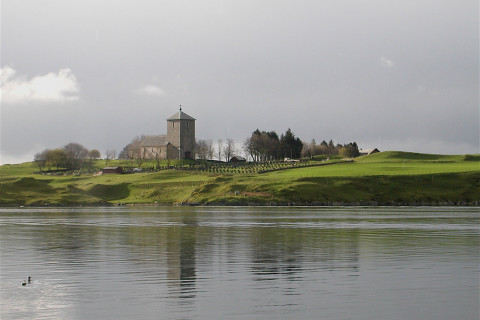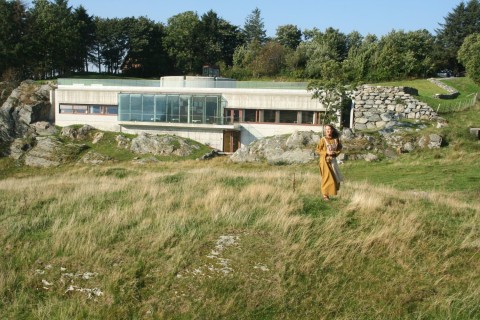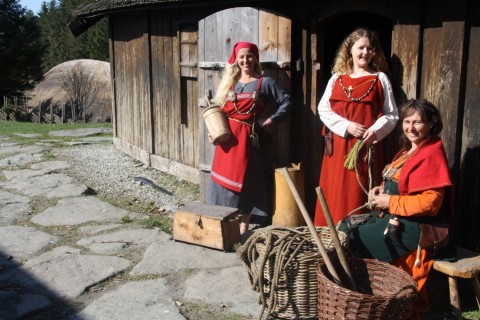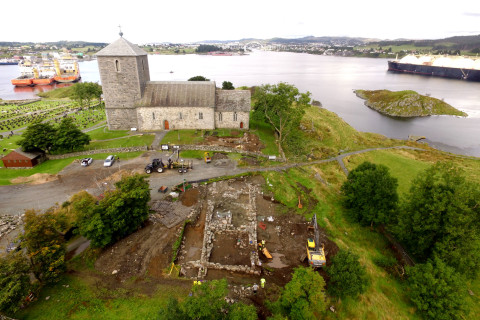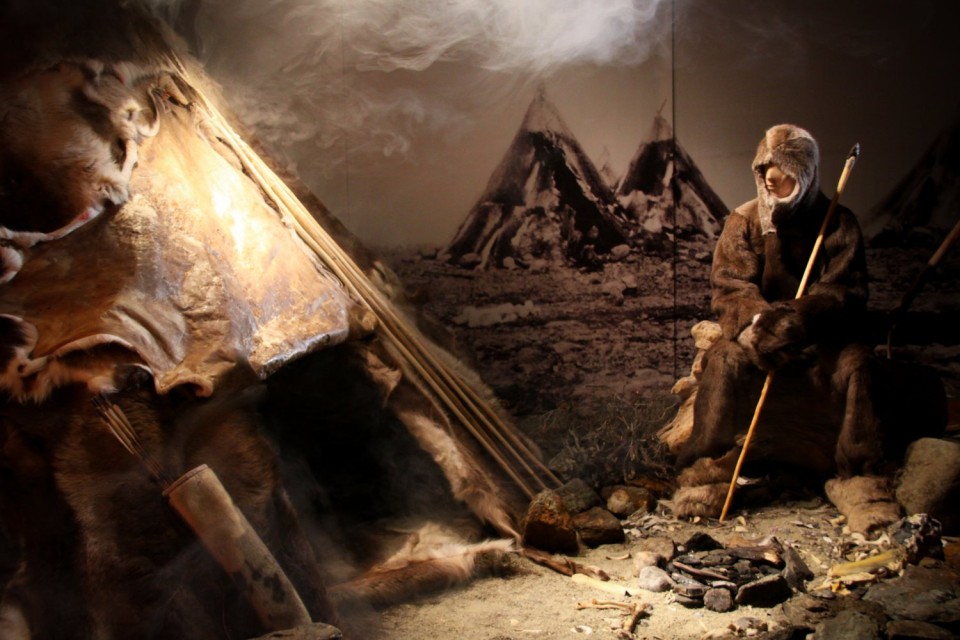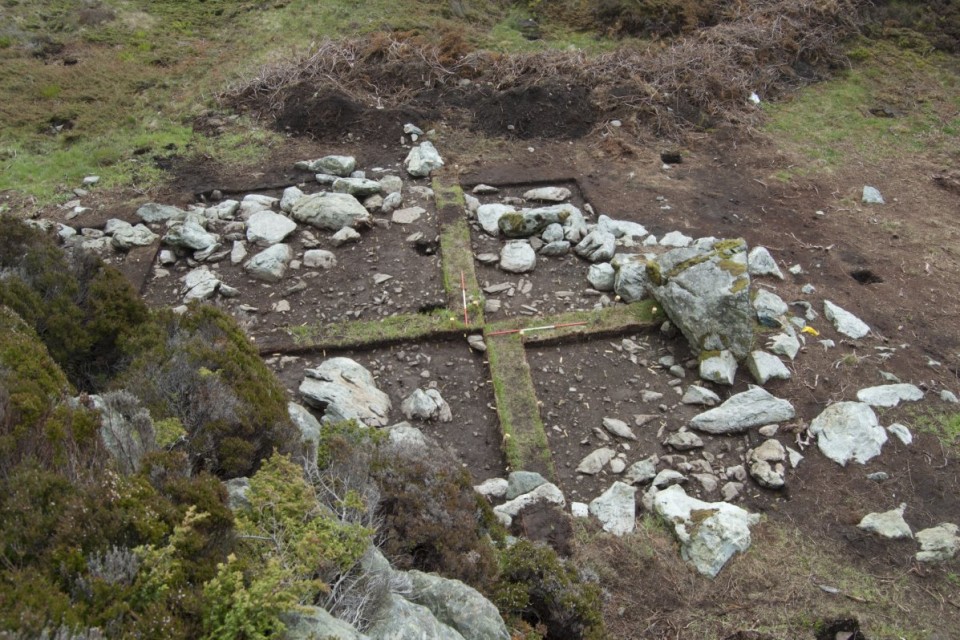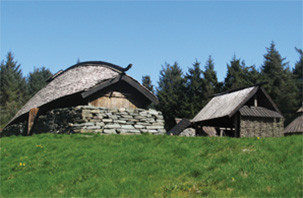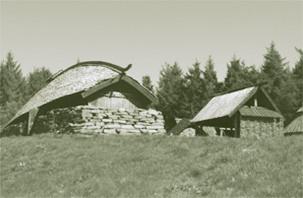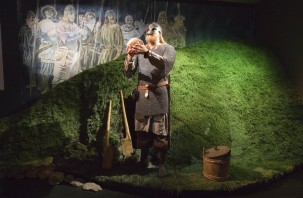Stone Age (12 000 – 1 800 BC)

NORTH SEA MAINLAND
Once you could walk safely from the Continent to the British Isles. (Ill Dag Frognes)
Text: Marit Synnøve Vea
The ice retreated from our land 14,000-15,000 years ago. And as the ice disappeared, people arrived. The oldest traces we have of humans in what is now Norway are about 12,000 years old. Karmøy is situated in the area which first emerged when the ice withdrew, but large parts of the country were still covered by a mantle of ice. Humans hunted for both seals and big game, but crustaceans and fish were also an important part of their diet.
Conditions affecting preservation mean that for the most part, only stone tools have been found from this era – hence the name “Stone Age”, but we know that the Stone Age people also used tools made of bone and wood. Needles were in use as early as 30,000 years ago and people were able to sew fine, warm clothes. Furthermore, they used combs on their hair and adorned themselves with amulets.
People may have been living in the area around Avaldsnes before the last Ice Age, in other words, at least 20,000 years ago, but there are no traces of them left.
The first settlers who left traces behind them came to the ice-free region of Southwest Norway from the ” North Sea Mainland”, which today lies below sea level, about 12,000 years ago. This area of land, sometimes called Doggerland, joined the British Isles to the Continent. It became flooded with water about 7,800 years ago, but was once inhabited by humans belonging to the so-called Ahrensburg culture.
THE SETTLEMENT AT BRATTHELGELAND, FOSEN
In 1998, Statoil was planning to lay a pipeline for channelling the flow of gas from the Åsgård Field via Kårstø and down towards the Continent. At the point where the pipeline crosses the strait of Karmsundet, one of Norway’s eldest and largest settlements was discovered at Bratthelgeland, Fosen.

AHRENSBURG SETTLEMENT AT BRATTHELGELAND, FOSEN.
From the excavations in 1998. (Photo Marit Synnøve Vea)
The settlement is about 10,000 years old and even though archaeologists only uncovered about half of the area, almost 40,000 finds were discovered there. They also found a long stone wall several metres long, which we believe constitutes Norway’s eldest windscreen wall, dating from the Late Stone Age.
This means that the Fosen settlement at Karmsundet is something more than an ordinary hunter’s dwelling. Stone Age people lived at Bratthelgeland during most of the year for many hundreds of years. Traces of these Stone Age dwellers have also been found at Rennesøy, Gjesdal and Tysvær and North Sea trawlers sometimes catch some of their tools in their nets.
THE AHRENSBURG CULTURE
So where did these people come from? It is now nearly 60 years since we first discovered traces of them at a place called Ahrensburg outside Hamburg. Around 12,000 years ago, these people migrated to what we call the North Sea Mainland – a piece of land now covered by the sea. Perhaps they stood on the shore and saw the cloud formations that told them that there was land on the other side of what we now call the Norwegian Trench. In light boats of animal hide, they crossed the ice-free stretch of water and arrived here at Karmsundet.
These people were no more Norwegians than they were Danes, Germans or Englishmen, but perhaps we can call them the “North Sea people”? They were long-distance nomads who travelled vast distances and probably crossed the Norwegian Trench several times during their lifetime.
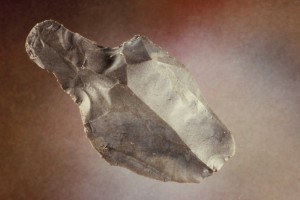
ARROWHEAD/SPEARHEAD FROM SNIK.
Resembles the so-called Lyngbo arrows from Denmark, found on 12,000 year old settlements.
We know little about their religion, but in Ahrensburg it was found a reindeer skull which was put on a pole in the sea, probably in connection with religious acts.
OTHER FINDS FROM THE ELDEST STONE AGE ERA
In 1910, a flake axe made of flint was found at Moksheim near Karmsund Bridge. By comparing it with similar finds in Denmark, we believe that this axe may be between 8,000 – 10,000 years old.
An arrowhead from Snik, found in 1951, might be even older and has a very ancient appearance. It resembles so-called Lyngbo arrows from Denmark, found on 12,000 year old settlements.
In 1978, an extremely old dwelling was also discovered at Utvik at the entrance to the Royal Court at Avaldsnes. This dwelling is around 9,000 years old.
THE BLEIVIK WOMAN (OR WAS IT A MAN?)
The oldest inhabitant of the county Rogaland that we know of was found at Bleivik, just north of Haugesund.
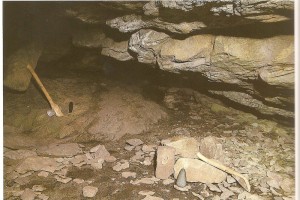
WITCH’S CAVE
Rocke shelter at Falnes, with many finds from the Stone Age. (Photo Ole Jakob Worrå)
The skeletal remains are about 8,200 years old and the site of the find would have been on the seabed at the time this person was alive. In accordance with our contemporary gender role patterns, we therefore thought that this was a man who had fallen out of a boat and drowned during a fishing expedition. Further examination revealed that this “man” was perhaps a woman aged around 60 who was out fishing to feed her family when she drowned some time over 8,000 years ago. She was 1.60 m tall and her skull bears a strong resemblance to human skulls today.
«TRÅDLAKÅNEHÅLÅ» (WITCH’S CAVE)
At Falnes, on the southern tip of Karmøy, there are two well-preserved rock shelters. One of them is called «Trodlakånehålå» (“witch’s cave”) and is 20 m long, 3 m wide and 3 m high. The other is 10 m long, 2 m wide and about 2 m high. Humans have lived in these shelters for long periods of time. They have never been studied by archaeologists, but a large number of objects have been found in them, made of flint, greenstone and rhyolite.
Agriculture was introduced into Norway around 5,000 years ago. Was it the “Bleivik woman’s” descendants who learned to cultivate the land, or was it rather that people who spoke the Indo-European language were the first to introduce agriculture in the Early Stone Age? The Stone Age population must in any case have had good contact with the outside world – one reason we know this is because of the “flint treasure” from Hauske.
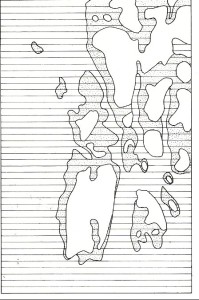
KARMØY 13 000 YEARS AGO.
The sea level is a lot higher than today. The landscape consists of islands, reefs and inlets (After Holtedahl and Andersen, 1960)
LATE STONE AGE (3 500 – 1 800 BC)
THE FLINT TREASURE FROM HAUSKE, TORVASTAD
There are over 100 sites with Stone Age finds situated along the northern part of Karmsundet. Most of these date from the Late Stone Age. If we were to choose just one of this finds, our choice would have to fall on the “flint treasure” from Hauske at Torvastad. When we talk about treasures found in the ground, we are usually referring to objects made of gold or silver. But the flint treasure that was buried in the ground at Hauske was just as valuable for the Stone Age people as many of the precious Iron Age finds were for the people during that period.
The objects were found in 1911 when a farmer was ploughing marshy land on his farm. He uncovered the largest collection of flint objects ever found in Norway: 27 daggers, a sickle, a flint axe, 4 scrapers and 214 large, disc-shaped flint cuttings. A similar, smaller collection of finds was discovered 10 years later at Utvik.
Had these objects been stored away for a purpose? Did somebody hide them because of war or turmoil, with the intention of fetching them later? Or were they perhaps placed in the marsh as an offering to higher powers? We do not know the answer, but the Hauske find clearly shows that the people at Karmsund must have had trade contacts with Denmark during the Stone Age because flint of this quality and in such quantities was not something that the retreating ice left on the beaches here in Norway.
STONE AGE DWELLINGS AT HELGANES
In 2011/2012, the Archaeological Museum in Stavanger carried out excavations at Helganes when the airport was being extended there. They found dwellings dating from both the Early and Late Stone Age and also from the Celtic Age.
These dwellings are located to the northwest, facing the sea amongst outcrops of rock on terrain that seems inhospitable to us. Here, on the sea edge, several houses from the Late Stone Age – an extremely rare phenomenon – have also been discovered.
Last update November 2022
Back



